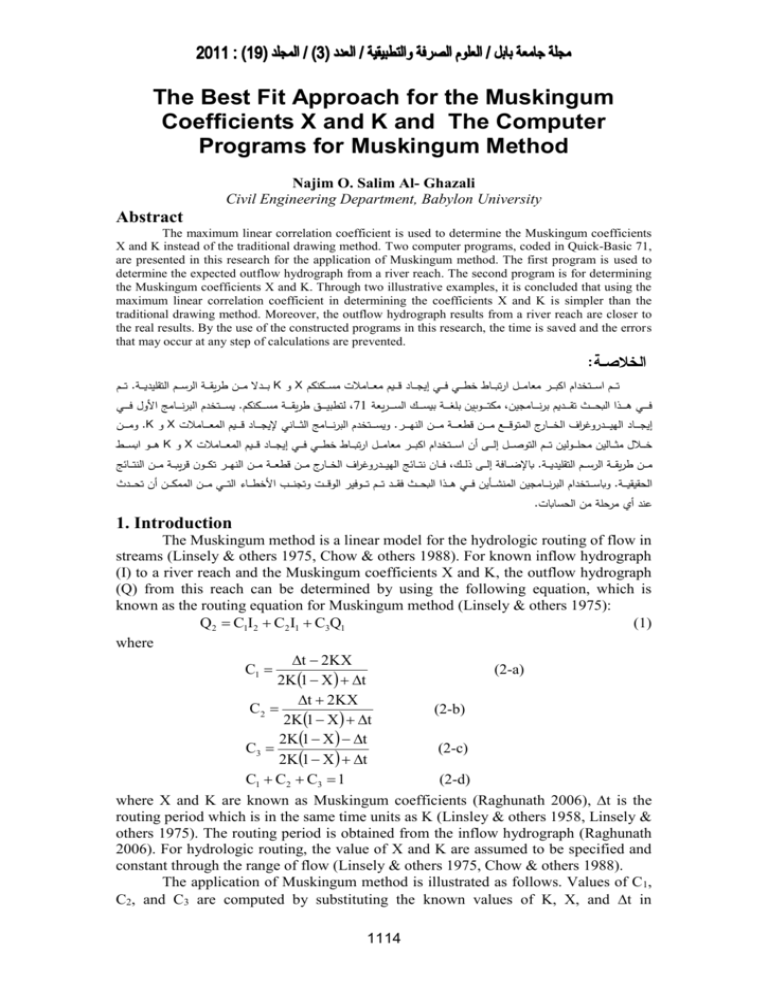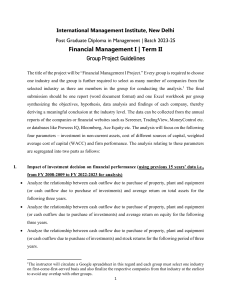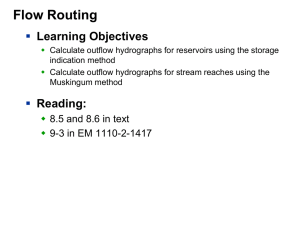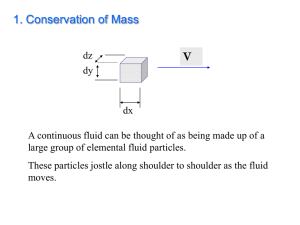
The Best Fit Approach for the Muskingum
Coefficients X and K and The Computer
Programs for Muskingum Method
Najim O. Salim Al- Ghazali
Civil Engineering Department, Babylon University
Abstract
The maximum linear correlation coefficient is used to determine the Muskingum coefficients
X and K instead of the traditional drawing method. Two computer programs, coded in Quick-Basic 71,
are presented in this research for the application of Muskingum method. The first program is used to
determine the expected outflow hydrograph from a river reach. The second program is for determining
the Muskingum coefficients X and K. Through two illustrative examples, it is concluded that using the
maximum linear correlation coefficient in determining the coefficients X and K is simpler than the
traditional drawing method. Moreover, the outflow hydrograph results from a river reach are closer to
the real results. By the use of the constructed programs in this research, the time is saved and the errors
that may occur at any step of calculations are prevented.
:الخالصــة
خ م م خ م مماخ ام م مملخدياام ممتخديت ي عم ممل ختم ممتخKخوخXتخ
ت خعام م ممتر تخدي ا م م ممط خدألولخف م م م خ
تم ممتخدام ممتر دتخدل م مماخ خط م م خدات م ممط خر م م خف م م خإيجم ممط خقم ممعتخ خم ممط م خ ا م م
خيت يم م ممةخ ام م م مملخ ا م م م71ف م م م خبم م مميدخدي ام م مممخت م م م عتخ ا م م ممط جيا خ تم م ممو ياخ م م مملخ عا م م م خديا م م مامخلخ
خو م م مماخKخوخXخ م م مماخق خ م مملخ م مماخدي ه م مما خوعا م ممتر تخدي ا م م ممط خدي م ممط خإليج م ممط خق م ممعتخدي خ م ممط م خ.إيج م ممط خديهيم م م اولادرخدير م ممطا خدي توق م مم
خبم مموخد ا م م خKخوخXرم ممملخ م ممطيياخ ا م ممويياختم ممتخديتو م م خإي م م خأاخدام ممتر دتخدل م مماخ خط م م خدات م ممط خر م م خف م م خإيجم ممط خقم ممعتخدي خم ممط م خ
م مماخ ام م مملخدياام ممتخديت ي عم ممل خ طإلضم ممطفلخإي م م خيي م م خفم ممطاخ تم ممطل خديهي م م اولادرخديرم ممطا خ م مماخق خم مملخ م مماخدي هم مماختلم ممواخقام م مملخ م مماخدي تم ممطل خ
م مماخأاختا م م مخ
ديا ع عم ممل خو طام ممتر دتخدي ا م ممط جياخدي بم ممقياخف م م خبم مميدخدي ام مممخف م م ختم ممتختم مموفياخديوق م م خوتج م م خدألر م ممط خديت م م خ م مماخدي
خخ
ع خأيخ اا لخ اخديااط ط
1. Introduction
The Muskingum method is a linear model for the hydrologic routing of flow in
streams (Linsely & others 1975, Chow & others 1988). For known inflow hydrograph
(I) to a river reach and the Muskingum coefficients X and K, the outflow hydrograph
(Q) from this reach can be determined by using the following equation, which is
known as the routing equation for Muskingum method (Linsely & others 1975):
Q2 C1I2 C2 I1 C3Q1
(1)
where
t 2KX
C1
(2-a)
2K 1 X t
t 2KX
C2
(2-b)
2K1 X t
2K1 X t
C3
(2-c)
2K1 X t
C1 C2 C3 1
(2-d)
where X and K are known as Muskingum coefficients (Raghunath 2006), t is the
routing period which is in the same time units as K (Linsley & others 1958, Linsely &
others 1975). The routing period is obtained from the inflow hydrograph (Raghunath
2006). For hydrologic routing, the value of X and K are assumed to be specified and
constant through the range of flow (Linsely & others 1975, Chow & others 1988).
The application of Muskingum method is illustrated as follows. Values of C1,
C2, and C3 are computed by substituting the known values of K, X, and t in
1114
Journal of Babylon University/Pure and Applied Sciences/ No.(3)/ Vol.(19): 2011
equations (2-a), (2-b), and (2-c) respectively. Values of I are given, and the products
C1I2 and C2I1 are computed. With an initial value of Q given or estimated, the product
C2Q1 is calculated and the three products added to obtain Q2. The computed value of
Q2 becomes Q1 for the next routing period and another value of Q can be determined.
The process continues as long as values of I are known.
These calculations are usually performed manually, which is time consuming,
especially when the data is large. Additionally, error may occur at any step of
calculations. Therefore, in this research a computer program, Program 1, is
constructed to perform all these calculations. Thus, the time is saved and the error that
may occur at any step of calculations is prevented.
The Muskingum coefficient, X, is a dimensionless constant for the reach of a
river (Raghunath 2006). It indicates the relative importance of the inflow and outflow
in determining storage (Linsley & others 1958, Linsely & others 1975, Linsley &
Franzini 1979). The constant X varies from 0 to 0.5 (Linsley & others 1958, Linsley
& Franzini 1979, Chow and others 1988). A value of zero indicates that the outflow
alone determine storage, as in a reservoir (Linsley & others 1958, Linsely & others
1975, Linsley & Franzini 1979). When X = 0.5, inflow and outflow have equal
influence on storage (Linsley & others 1958, Linsley & Franzini 1979). In natural
channels X ranges from 0.1 to 0.3 (Linsley & Franzini 1979, Raghunath 2006).
The Muskingum coefficient, K, known as the storage constant, is the ratio of
storage to discharge and has the dimension of time (Linsley & Franzini 1979,
Raghunath 2006). The value of K approximates the travel time of the wave through
the reach (Linsely & others 1975, Linsley & Franzini 1979). In the absence of good
data, the value of K may be estimated as the observed time of travel of peak flow
through the reach (Linsley & others 1958, Chow & others 1988).
If observed inflow and outflow hydrographs are not available for a river reach,
the values of X and K may be estimated using Muskingum-Cunge method described
in Chow and others 1988. This method is used for determining the values of K and X
on the basis of channel characteristics and flow rate in the channel (Chow and others
1988).
When observed inflow and outflow hydrographs are available for a river
reach, the values of X and K can be determined. Assuming various values of X and
using known values of the inflow and outflow, successive values of the numerator and
denominator of the following expression for K can be computed (Linsely & others
1975, Chow & others 1988):
I Q t
K
(3)
XI 1 X Q
where and are the average inflow and outflow respectively. The computed values
of the numerator and denominator are plotted. This usually produces a graph in the
form of a loop (Linsley & others 1958, Linsely & others 1975, Linsley& Franzini
1979, Chow and others 1988, Raghunath 2006). The value of X that produces a loop
closest to a single line is taken to be the correct value for the reach, and K, according
to Eq. (3), is equal to the slope of the line.
This method for determining the values of X and K parameters, which may be
called as drawing method, may be considered as time consuming and tedious method.
Moreover, there will be no general agreement among the researchers on the values of
X and K parameters. This is because the loop closest to a single line is determined by
visual interpretation and thus is greatly subjective. In this research, the maximum
linear correlation coefficient is used to determine the values of X and K parameters
1115
instead of the traditional drawing method. Program 2, presented in this study, is used
to determine the values of X and K parameters. Thus, the time is saved, different
values of X with small intervals can be used, and the outflow hydrograph results from
a river reach will be close to the real results.
The two programs constructed in this research are listed in Appendix 1 and
Appendix 2, instead of listing flow charts, in order to make the researchers benefit
from them.
Two examples will be considered in this research, and the results are obtained
by using the constructed programs.
2. The Best Fit Approach for the Muskingum Coefficients X and K
As said in the introduction, the drawing method for determining the values of
Muskingum coefficients X and K may be considered as time consuming and tedious
method. In this research, the maximum linear correlation coefficient is used to
determine the values of X and K parameters instead of the traditional drawing
method.
Observed inflow and outflow hydrographs for a river reach are assumed to be
available. The variable z is assumed to represent the denominator of Eq. 3 and the
variable y is assumed to represents the numerator of Eq. 3. That is,
(4)
Z XI 1 XQ
y I Q t
(5)
For any value of the Muskingum coefficient X (0 X 0.5), the average values
of inflow ( ), the average values of outflow ( ), the difference of inflow (I), and the
difference of outflow (Q) are computed. Substituting these values into Eq.4 and
Eq.5, N points (z, y) will be obtained, where n is the number of data and N (N = n - 1)
is the number of points. For these points, the linear correlation coefficient is required
to be determined. The linear correlation coefficient is computed from the following
equation (Gerald 1984, McCUEN 1985, Johnson & Kuby 2004):
N zy z y
R
(6)
2
2
N z 2 z N y 2 y
Computing z and y values for every X (0 X 0.5) manually represents a
cumbersome method. Therefore, the computer program, Program 2, is constructed in
this research to compute the correlation coefficient for every X (0 X 0.5). The
value of X that produces the maximum linear correlation coefficient is taken to be the
correct value for the reach.
The Muskingum coefficient K is equal to the slope of the best fit line. If the
best fit line equation is of the form:
y = a + bz
(7)
then b represents the slope of the best fit line and is equal to the constant K. Both a
and b can be found using the least squares method (Gerald 1984, McCUEN 1985),
numerical methods, such as Gauss-Newton method (Burden & Faires 2001, Chapra &
Canale 2006), optimization methods, such as Nelder-Mead method (Mathews & Fink
2004), or software, such as grapher, Statistical, or Curve Expert. However, the
coefficient (a) in Eq.7 is not required, and the slope of the best fit line, b (= K), can be
directly determined using the following equation (Johnson & Kuby 2004):
N zy z y
K
(8)
2
N z 2 z
Program 2 computes K for every value of R.
1116
Journal of Babylon University/Pure and Applied Sciences/ No.(3)/ Vol.(19): 2011
3. Program 1
Program 1 is presented in Appendix 1. For known inflow hydrograph to a river
reach, the time interval t, and the values of X and K parameters, the outflow
hydrograph from this reach can be determined using the following equation:
Q j1 C1I j1 C 2 I j C3Q j (9)
where C1, C2, and C3 are defined by equations 2-a, 2-b, and 2-c respectively.
The input and output variables of Program 1 are as follows:
Variable
Description
X
Dimensionless constant
K
Storage constant
DT
The time interval
C1, C2, and C3 Constants defined by equations 2-a, 2-b, and 2-c respectively
N
Number of data
IN
Inflow hydrograph
Z1
C1I j1
Z2
C2I j
Z3
C 3Q j
OE
Expected outflow hydrograph (OE = Z1 + Z2 + Z3)
4. Program 2
Program 2 is presented in Appendix 2. Inflow and outflow hydrographs to a
river reach are assumed to be known. For any value of the Muskingum coefficient X
(0 X 0.5), the variables z and y, defined by the following equations, are computed:
Z XI j1 I j 1 X Q j1 Q j
(10)
y 0.5t I j1 I j Q j1 Q j
(11)
The linear correlation coefficient for the points (z, y) is computed by Eq.6, and
the storage constant, K, is computed by Eq.8.
The input and output variables of Program 2 are as follows:
Variable
Description
N
Number of data
DT
The time interval
IN
Inflow hydrograph
O
outflow hydrograph
X
Dimensionless constant
z
variable, defined by Eq.10
y
variable, defined by Eq.11
R
The linear correlation coefficient
K
Storage constant
Example 1
The inflow hydrograph readings for a stream reach are given below for which
the Muskingum coefficients of K=36 hr and X=0.15 apply. Route the flood through
the reach and determine the outflow hydrograph. Assume Q1 equal to I1= 42 cumec
(Raghunath 2006, Example 9.3, pp. 272).
1117
Time (hr)
0
12 24
36
48
60
72
84
96
108 120
Inflow (cumec) 42 45 88 272 342 288 240 198 162 133 110
Time (hr)
132 144 156 168 180 192 204 216 228 240
Inflow (cumec) 90 79 68 61 56 54 51 48 45 42
Solution
The following Table shows the results obtained from Program 1, with that
obtained by Raghunath:
Table 1: Stream flow routing by the Muskingum method
(Program 1 and Raghunath results)
Inflow
Outflow (Q) Outflow (Q)
Time
C1Ij+1
C2Ij
C3Qj
I
(cumec)
(cumec)
(hr)
(cumec) (cumec) (cumec)
(cumec)
(Program 1) (Raghunath)
0
42
0.00
0.0
0.0
42.0
42.0
12
45
0.74
13.1
28.2
42.0
42.1
24
88
1.44
14.0
28.3
43.7
44.0
36
272
4.46
27.4
29.4
61.3
62.2
48
342
5.61
84.7
41.2
131.5
132.8
60
288
4.72
106.5
88.4
199.6
200.7
72
240
3.93
89.7
134.2
227.8
233.0
84
198
3.25
74.8
153.1
231.1
234.0
96
162
2.66
61.7
155.3
219.7
221.6
108
133
2.18
50.5
147.6
200.3
201.0
120
110
1.80
41.4
134.6
177.8
178.9
132
90
1.48
34.3
119.5
155.3
155.7
144
79
1.30
28.0
104.4
133.7
133.5
156
68
1.11
24.6
89.9
115.6
115.3
163
61
1.00
21.2
77.7
99.9
99.7
180
56
0.92
19.0
67.1
87.0
86.8
192
54
0.89
17.4
58.5
76.8
76.7
204
51
0.84
16.8
51.6
69.3
69.1
216
48
0.79
15.9
46.6
63.2
63.1
228
45
0.74
15.0
42.5
58.2
58.0
240
42
0.69
14.0
39.1
53.8
53.6
The difference between the outflow results obtained by Program 1 and
Raghunath belongs to the C1, C2, and C3 values.
For Program 1: C1= 1.639344E-02 C2= 0.3114754 C3= 0.6721312
For Raghunath: C1= 0.02 C2= 0.31 C3= 0.67
Additionally, the products C1I2, C2I1, and C2Q1 are not approximated by Program 1.
Thus, the outflow results obtained by Program 1 are different from that obtained by
Raghunath.
Example 2
The inflow and outflow hydrographs for a reach of a river are given below.
Determine the value of the Muskingum coefficients K and X for the reach (Raghunath
2006, Example 9.2, pp. 271).
1118
Journal of Babylon University/Pure and Applied Sciences/ No.(3)/ Vol.(19): 2011
Time (hr)
0
Inflow (cumec)
24
48
72
96
120 144 168 192 216
35 125 575 740 456 245 144
95
67
50
Outflow (cumec) 39 52 287 624 638 394 235 142 93 60
Solution
Program 2 results are X = 0.19 and k = 0.688 while Raghunath results are X =
0.25 and k = 0.7. Figures 1 and 2 show these results.
300
original data
Best fit line
200
y (Eq.5)
100
0
-100
-200
-400
-200
0
200
400
z (Eq.4)
Fig.1: Program 2 results (X = 0.19, k = 0.688)
300
original data
Best fit line
200
y (Eq.5)
100
0
-100
-200
-400
-200
0
200
400
z (Eq.4)
Fig.2: Raghunath results (X = 0.25, k = 0.7)
The linear correlation coefficients for the two cases are computed using Eq.6,
and it is found that R= 0.9971 for Program 2 and R= .9958 for Raghunath. Thus, it
can be concluded that Program 2 results are better than Raghunath results.
1119
When another inflow and outflow hydrographs for the same river reach are
known, the comparison between Program 2 results and Raghunath results will be
further clear. The inflow data and X and k values are used to find the expected
outflow. The X and k values that produce outflow results closer to the measured
outflow will be the best values. Another inflow and outflow hydrographs for the same
river reach are not known. Therefore, the residual sum of squares will be used. It is
defined by the following equation:
n
E MO i COi
2
(12)
i 1
where
E = Residual sum of squares
MO = Measured outflow
CO = Computed outflow
Table 2 shows the computed and measured outflow hydrographs for the case
Q1 = I1 = 35 cumec. The residual sum of squares results are as follows:
Case
E
X=0.19, K = 0.688 824.75
X=0.25, K = 0.7 1158.45
Thus, it can be concluded that Program 2 results are better than Raghunath results.
Table 2: Computed Outflow with Measured Outflow
(Q1 is assumed equal to I1 = 35 cumec)
measured Computed Outflow Computed Outflow
outflow
X=0.19, K = 0.688
X=0.25, K = 0.7
39
35
35
52
66.43
63.53
287
279.00
266.18
624
616.59
619.79
638
634.12
647.01
394
391.95
393.76
235
217.68
216.60
142
130.88
130.23
93
87.16
86.98
60
62.15
62.10
Table 3 shows the computed and measured outflow hydrographs for the case
Q1 equal to measured Q1 = 39 cumec.
1120
Journal of Babylon University/Pure and Applied Sciences/ No.(3)/ Vol.(19): 2011
Table 3: Computed Outflow with Measured Outflow
(Q1 is assumed equal to measured Q1 = 39 cumec)
measured Computed Outflow Computed Outflow
outflow
X=0.19, K = 0.688
X=0.25, K = 0.7
39
39
39
52
66.65
63.63
287
279.01
266.19
624
616.59
619.79
638
634.12
647.01
394
391.95
393.76
235
217.68
216.60
142
130.88
130.23
93
87.16
86.98
60
62.15
62.10
The residual sum of squares results are as follows:
Case
E
X=0.19, K = 0.688 814.99
X=0.25, K = 0.7 1144.55
Thus, it can be concluded that Program 2 results are better than Raghunath results.
5. Conclusions
The use of the maximum linear correlation coefficient in determining the
coefficients X and K is simpler than the traditional drawing method. Moreover, the
computed outflow hydrograph results from a river reach are closer to the real results.
By the use of the constructed programs in this research, the time is saved and the
errors that may occur at any step of calculations are prevented.
6. Recommendations
When the inflow and outflow hydrographs data for any reach in Iraqi rivers are
available, application of Program 2 is recommended to determine the
Muskingum coefficients X and K. Then, for known another inflow hydrograph
to this reach, Program 1 is recommended to determine the expected outflow
hydrograph from this reach.
B. For known inflow hydrograph to any reach in Iraqi rivers and the Muskingum
coefficients X and K, Program 1 is recommended to determine the expected
outflow hydrograph from this reach.
A.
References
Burden, R.L. and Faires, J.D. (2001). “Numerical Analysis.” Wadsworth Group
Books, USA.
Chapra, S.C., and Canale, R.P. (2006). “Numerical Methods for Engineers." 5th ed.,
McGraw Hill, USA.
Chow, V.T., Maidment, D.R., and Mays, L.W. (1988). “Applied Hydrology.”
McGraw-Hill, New York.
Gerald, G.F. (1984). “Applied Numerical Analysis." Addison-Wesley publishing
Company, USA.
Johnson, R. and Kuby, P. (2004). “Elementary Statistics." 9th ed., Thomson, USA.
Linsely, R.K. and others (1975). “Hydrology for Engineers.” McGraw- Hill Book
Company, Inc., New York.
Linsley, R.K. and Franzini, J.B. (1979). “Water-Resources Engineering.” 3rd edition,
McGraw-Hill, New York.
1121
Linsley, R.K., Kohler M.A., and Poulhus, J.L. (1958). “Hydrology for Engineers.”
McGraw-Hill, USA.
Mathews, J.h. and Fink, J.D. (2004). "Numerical Methods Using Matlab." 4th ed.,
Pearson Prentice Hall, USA.
McCUEN, R.H. (1985). “Statistical Methods for Engineers.” Prentice-Hall, USA.
Raghunath, H.M. (2006). “Hydrology.” 2nd ed., New Age International (P) Limited,
India.
Appendix1: Program 1
CLS
X = ?: K = ?: DT = ?
C = 2 * K * (1 - X) + DT
C1 = (DT - 2 * K * X) / C
C2 = (DT + 2 * K * X) / C
C3 = (2 * K * (1 - X) - DT) / C
N=?
DIM IN(N), Z1(N), Z2(N), Z3(N), OE(N)
FOR I = 1 TO N: READ IN(I): NEXT I
DATA
OE(1) = ?
FOR I = 2 TO N
Z1(I) = C1 * IN(I)
Z2(I) = C2 * IN(I - 1)
Z3(I) = C3 * OE(I - 1)
OE(I) = Z1(I) + Z2(I) + Z3(I)
PRINT Z1(I), Z2(I), Z3(I), OE(I)
NEXT I
END
Appendix 2: Program 2
CLS
N =?: DT =?
DIM IN(N), O(N), SUIN(N - 1), DFIN(N - 1), SUO(N - 1), DFO(N - 1), z(N-1), y(N-1)
FOR I = 1 TO N: READ IN(I): NEXT I
DATA
FOR I = 1 TO N: READ O(I): NEXT
DATA
FOR X = 0 TO .5 STEP .01
FOR I = 1 TO N - 1
SUIN(I) = IN(I + 1) + IN(I): DFIN(I) = IN(I + 1) - IN(I): SUO(I) = O(I + 1) + O(I): DFO(I) =
O(I + 1) - O(I)
z(I) = X * DFIN(I) + (1 - X) * DFO(I): y(I) = .5 * DT * (SUIN(I) - SUO(I))
SUMz = SUMz + z(I): SUMz2 = SUMz2 + (z(I)) ^ 2: SUMy = SUMy + y(I):
SUMy2 = SUMy2 + (y(I)) ^ 2: SUMzy = SUMzy + z(I) * y(I)
NEXT I
R1 = (N - 1) * SUMzy - SUMz * SUMy: R2 = (N - 1) * SUMz2 - (SUMz) ^ 2
R3 = (N - 1) * SUMy2 - (SUMy) ^ 2: R4 = (R2 * R3) ^ .5: R = R1 / R4: K = R1 / R2
PRINT X, R, K
PRINT
SUMz = 0: SUMz2 = 0: SUMy = 0: SUMy2 = 0: SUMzy = 0
NEXT X
END
1122








